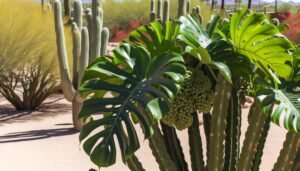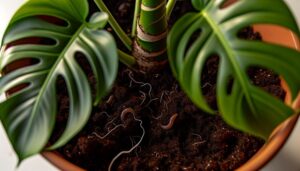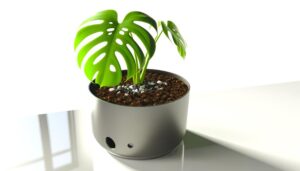Is There a Plant Guide for Monstera Deliciosa in South Florida?
Yes, there's a plant guide for Monstera deliciosa tailored to South Florida's environment. The region's tropical monsoon climate, with temperatures from 68°F to 90°F and high humidity, is ideal for growth.
Make sure your Monstera has well-draining, nutrient-rich soil with a pH between 5.5 to 7.0. Water when the top inch of soil is dry and maintain humidity above 40%.
Use neem oil or insecticidal soap to manage pests like spider mites. Valuable resources include the University of Florida's IFAS Extension, Fairchild Tropical Botanic Garden workshops, and the book 'Growing Tropical Plants in Florida' by B.
Schaffer. Discover more to perfect your Monstera care.

Key Takeaways
- University of Florida's IFAS Extension provides detailed Monstera care fact sheets specific to South Florida.
- Fairchild Tropical Botanic Garden offers workshops on growing Monstera deliciosa in South Florida's climate.
- 'Growing Tropical Plants in Florida' by B. Schaffer includes scientific insights on Monstera care.
- Local horticulturists can provide personalized advice for Monstera care in South Florida.
- Online forums like the Tropical Plant Society connect you with experienced Monstera growers.
Understanding South Florida's Climate
South Florida's climate, characterized by its tropical monsoon conditions, provides an ideal environment for the growth of Monstera deliciosa. You'll find that the region's high humidity levels, averaging around 70-90%, create a perfect habitat.
According to the Köppen-Geiger climate classification, South Florida falls under the Aw category, meaning a tropical wet and dry climate. This includes a distinct wet season from May to October, supplying ample water for Monstera's needs.
Additionally, temperatures range from 68°F during winter to 90°F in summer, staying within Monstera's optimal growth range of 65-85°F. The consistent warmth and moisture promote vigorous growth, making South Florida a haven for this species.
Understanding these conditions will help you cultivate a thriving Monstera deliciosa.
Soil Requirements for Monstera
To secure your Monstera deliciosa thrives, you need to provide well-draining, nutrient-rich soil. Aim for a mix that includes peat moss, pine bark, and perlite. These components improve aeration and drainage, preventing root rot.
According to research by the University of Florida, a pH range of 5.5 to 7.0 is ideal for nutrient uptake. Adding compost can enhance organic matter, supplying essential nutrients like nitrogen, phosphorus, and potassium. Avoid compacted soils, as they limit root expansion and oxygen availability.
Regularly check soil consistency; it should be slightly moist but not waterlogged. By adhering to these soil requirements, you ensure optimal growth conditions for your Monstera deliciosa in the unique climate of South Florida.
Watering and Humidity Needs
Beyond soil requirements, maintaining appropriate watering and humidity levels is essential for the health of your Monstera deliciosa. Water your plant when the top inch of soil feels dry, ensuring thorough saturation without waterlogging the roots. Overwatering can lead to root rot, a common issue in Monstera care (Chong et al., 2009).
South Florida's humidity, often above 60%, generally suits Monstera well. However, indoor environments might need additional humidity. Use a hygrometer to monitor levels, and consider a humidifier or regular misting if the humidity falls below 40%. Leaves showing brown edges often indicate insufficient humidity (Arifin et al., 2015).
Maintaining these parameters will support your Monstera's robust growth and overall health.
Pests and Diseases to Watch
Monitoring your Monstera deliciosa for pests and diseases is crucial to maintain its long-term health and well-being. Common pests include spider mites (Tetranychidae), which cause stippling and webbing on leaves, and scale insects (Coccoidea), identifiable by their waxy coatings. Root rot, often due to overwatering, manifests as yellowing leaves and mushy roots. Fungal infections such as leaf spot (Mycosphaerella) present as brown or black lesions.
Consistently check for early signs like discolored foliage or unusual patterns. Utilize neem oil or insecticidal soap for pest control, and ensure proper drainage to prevent root rot. Refer to scientific literature, such as the University of Florida's IFAS Extension, for detailed diagnosis and treatment strategies. Regular inspections can prevent significant harm.
Best Local Resources and Guides
For comprehensive care and accurate diagnosis, turn to local resources and guides such as university extensions, botanical gardens, and expert horticulturists.
The University of Florida's IFAS Extension provides detailed fact sheets and diagnostic services specific to Monstera deliciosa.
Fairchild Tropical Botanic Garden offers workshops and expert consultations tailored to South Florida's unique climate.
Engaging with local horticulturists can help you address specific issues like humidity requirements and pest infestations.
Utilize publications like 'Growing Tropical Plants in Florida' by B. Schaffer for scientifically-backed insights.
Online forums like the Tropical Plant Society can also connect you with experienced growers.
Leveraging these resources guarantees your Monstera thrives in South Florida's conditions, promoting its health and growth scientifically and effectively.
Conclusion
To sum it up, growing Monstera deliciosa in South Florida is a breeze if you understand the local climate, soil, and watering needs. Keep an eye out for pests and diseases, and make the best use of local resources for expert advice.
By following this guide, you'll have a thriving Monstera that's the envy of your neighborhood. Remember, the devil is in the details, so pay close attention to each aspect for best growth.






